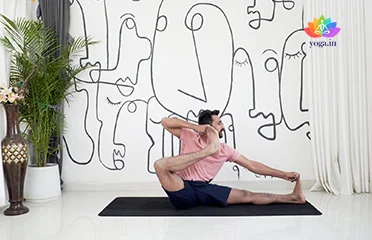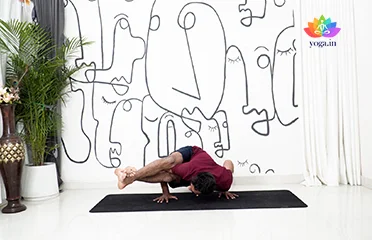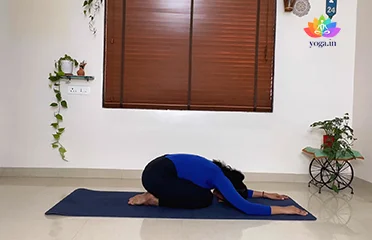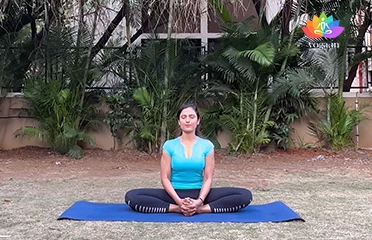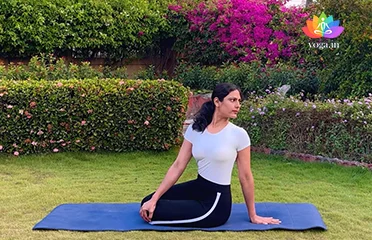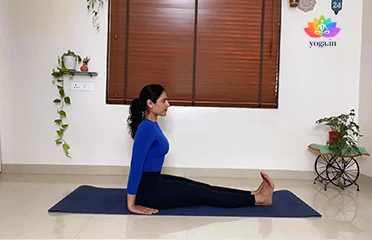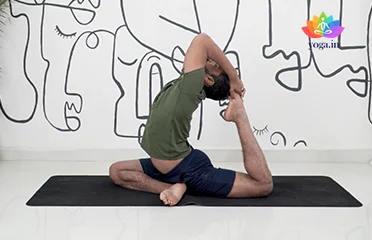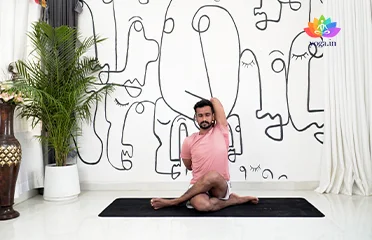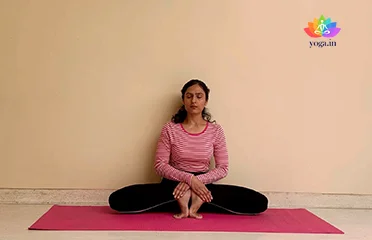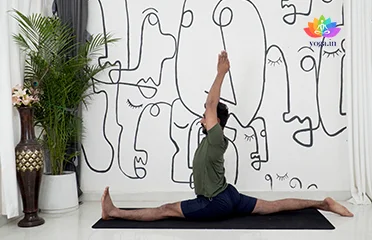Akarna Dhanurasana (Archer Pose)
अकर्णा धनुरासन / Archer Pose
The Sanskrit name is derived from Akarna (अकर्णा ) meaning towards [�K]
Astavakrasana (Eight-Angle Pose)
अष्टवक्रासन / Eight-Angle Pose
The sanskrit name is derived from ashta (अष्ट) meaning eight, Vakra [�K]
Balasana (Child’s Pose)
बालासना / Child's Pose
The Sanskrit name is derived from Bala (बाला) meaning child and āsana [�K]
Bhadrasana (Gracious Pose | Butterfly Po
भद्रासन / Gracious Pose | Butterfly Pose
The Sanskrit name is derived from Bhadra (भद्रा) meaning gracious, [�K]
Bharadvajasana (Seated Spinal Twist)
भरद्वाजसन / Seated Spinal Twist
The Sanskrit name is derived from Bhardvaja (भरद्वाज) means bringing [�K]
Dandasana (Stick Pose)
दण्डासन / Stick Pose
The Sanskrit name is derived from Danda (दण्डा) meaning stick and [�K]
Eka Pada Rajakapotasana (King Pigeon Pos
एक पद राजकपोटासन / King Pigeon Pose
The Sanskrit name is derived from Eka (एक) meaning one, Pada (पाद) [�K]
Gomukhasana (Cow Face Pose)
गोमुखासन / Cow Face Pose
The Sanskrit name is derived from Gau (गो) meaning cow, Mukh meaning face [�K]
Gorakshasana (Cowherd Pose)
गोरक्षासन / Cowherd Pose
The Sanskrit name is derived from the word Goraksha (गोरक्षा) [�K]
Hanumanasana (Monkey Pose)
हनुमानासन / Monkey Pose
The Sanskrit name is derived from the Hindu God -Hanuman (हनुमान) [�K]
- 1
- 2
- 3
Seated Yoga Poses: Relieve Discomfort & Enhance Flexibility
Seated yoga poses, or asanas, offer a profound way to cultivate inner peace, flexibility, and strength. These postures are accessible to individuals of all fitness levels and can be practiced anywhere, making them a convenient choice for busy lifestyles. By focusing on the breath and body alignment, seated poses can help alleviate stress, improve posture, and enhance overall well-being.
Benefits of Seated Yoga Poses
- Improved flexibility: Regular practice of seated poses can increase flexibility in the hips, spine, and lower back.
- Enhanced focus and concentration: Seated poses require mental focus, helping to improve concentration and mindfulness.
- Reduced stress and anxiety: The calming nature of seated poses promotes relaxation and stress reduction.
- Improved posture: Regular practice can help correct postural imbalances and strengthen the core.
- Digestive benefits: Certain seated poses can aid digestion and alleviate discomfort.
List of Seated Yoga Poses
- Sukhasana (Easy Pose): A foundational pose, Sukhasana involves sitting cross-legged with a comfortable spine. It’s a great starting point for beginners.
- Vajrasana (Thunderbolt Pose): Kneeling with buttocks resting on heels, this pose improves digestion and grounding.
- Dandasana (Staff Pose): Sitting upright with legs extended, Dandasana strengthens the spine and core.
- Paschimottanasana (Seated Forward Fold): This pose stretches the hamstrings, lower back, and spine, promoting flexibility and relaxation.
- Baddha Konasana (Butterfly Pose): A hip-opening pose that also stretches the inner thighs and groin.
- Ardha Matsyendrasana (Half Spinal Twist): This twisting pose helps improve spinal flexibility and digestion.
- Virasana (Hero Pose): Kneeling with knees together and hips on heels, this pose strengthens the ankles and knees.
- Padmasana (Lotus Pose): A challenging pose that requires flexibility and practice, Padmasana is considered a meditative posture.
Tips for Practicing Seated Yoga Poses
- Use props: Blankets, blocks, and chairs can be helpful for support and comfort.
- Focus on breath: Deep and steady breathing enhances the benefits of the poses.
- Start slowly: Begin with simpler poses and gradually progress as your flexibility improves.
- Find a comfortable space: Choose a quiet place where you won’t be disturbed.
- Practice regularly: Consistent practice is key to reaping the full benefits of seated yoga.
Common Challenges and How to Overcome Them
- Tight hips: Use props like blankets or blocks to support your hips and gradually increase flexibility.
- Back pain: Focus on core engagement and avoid rounding the back.
- Difficulty sitting cross-legged: Explore alternative poses like Dandasana or Virasana.
- Mind wandering: Bring your attention back to the breath and body to maintain focus.


